The Structure and Function in Living Things - PowerPoint PPT Presentation
1 / 17
Title:
The Structure and Function in Living Things
Description:
The Structure and Function in Living Things Chapter Fifteen: The Diversity of Life 15.1 Taxonomy and Systematics 15.2 Algae and Fungi Investigation 15B What is mold ... – PowerPoint PPT presentation
Number of Views:159
Avg rating:3.0/5.0
Title: The Structure and Function in Living Things
1
(No Transcript)
2
The Structure and Function in Living Things
3
Chapter Fifteen The Diversity of Life
- 15.1 Taxonomy and Systematics
- 15.2 Algae and Fungi
4
Investigation 15B
Bread Mold
- What is mold and how does it grow on bread?
5
15.2 Evolution of sexual reproduction
- The first prokaryotic cells appeared about 3
billion years ago. - Prokaryotic cells reproduce asexually by
splitting in two. - Asexual reproduction does not allow for genetic
variation unless a mutation occurs.
6
15.2 Evolution of sexual reproduction
- About 1 billion years ago, the first eukaryotic
cells appeared. - Eukaryotic cells evolved the ability to reproduce
sexually. - Organisms that reproduce sexually produce more
genetic variation among their offspring.
7
15.2 Evolution of sexual reproduction
- Sexual reproduction increases genetic variation
and leads to new species.
8
15.2 Protista
- The Kingdom Protista, often called protists,
contains many groups that evolved separately. - Scientists categorize the many groups under three
main types.
9
15.2 Algae
- Algae are photosynthetic protists that are
plant-like in many ways. - Kelp is a good example of multicellular algae.
10
15.2 Algae
- Some multicellular algae, such as Ulva, follow a
pattern of reproduction called alternation of
generations.
11
15.2 Fungi
- Originally classified as plants, fungi (singular
fungus) do not make their own food. - Yeast, mushrooms, molds, and are examples of
organisms in the Kingdom Fungi.
12
15.2 Fungi
- Fungi do not eat their food as animals do.
- Instead, they release digestive enzymes into
their surroundings. - The enzymes break down organic material and the
fungi absorb the nutrients directly into their
cells.
13
15.2 Fungi
- Some fungi live in symbiotic relationships with
algae, bacteria, or plants. - In those relationships, both the fungi and the
other organism benefit.
Lichens are made of two organismsa fungus, and a
green algae or cyanobacteria.
14
15.2 Fungi
- All fungi are made up of thread-like filaments
called hyphae. - The cells that make up the hyphae sometimes
contain two, three, or even more nuclei. - The hyphae form a cottony mass of threads called
a mycelium.
15
(No Transcript)
16
Ecology Connection
Likeable Lichens
- Lichens are important indicators of a healthy
ecosystem. - Many lichens are sensitive to chemical pollutants.
17
Activity
How to Make a Simple Cladogram
- In this activity, you will use fruit to learn how
to make a simple cladogram.

